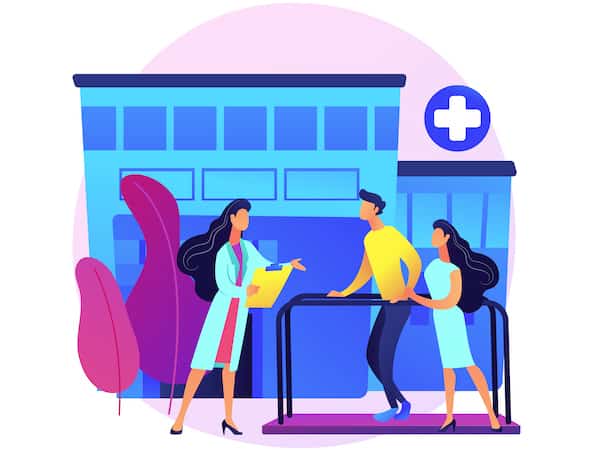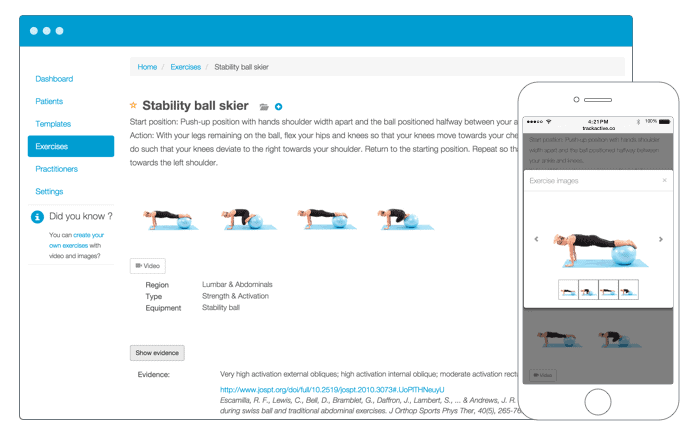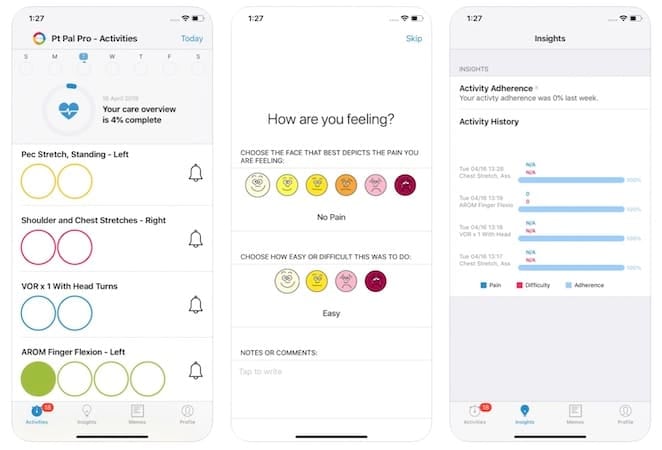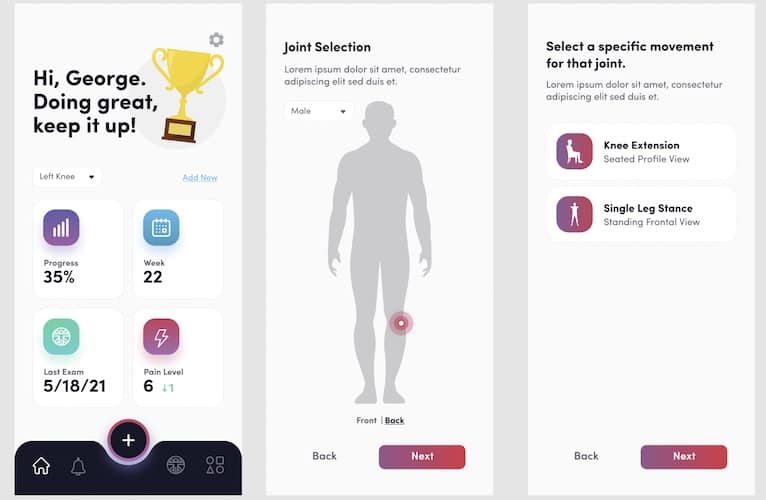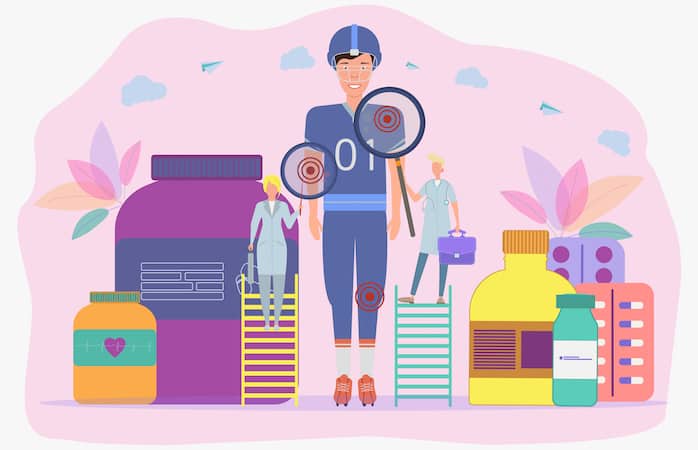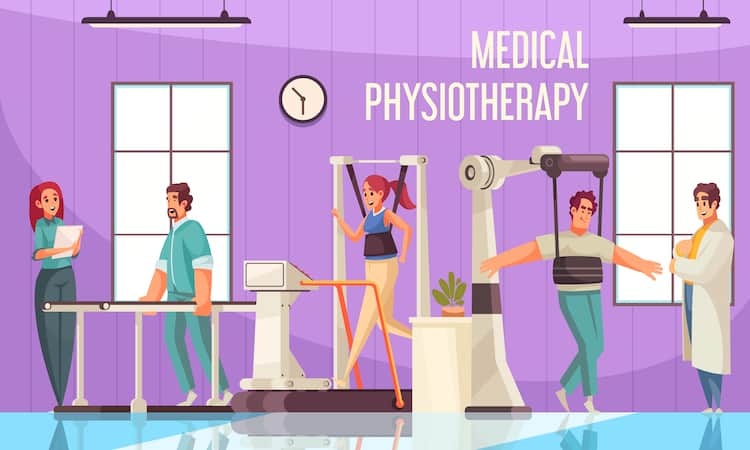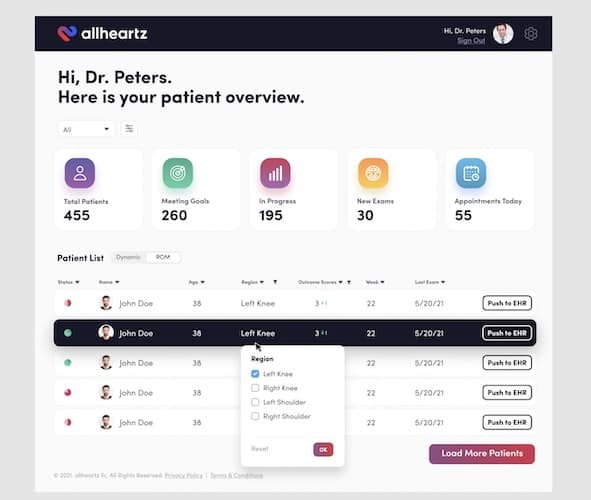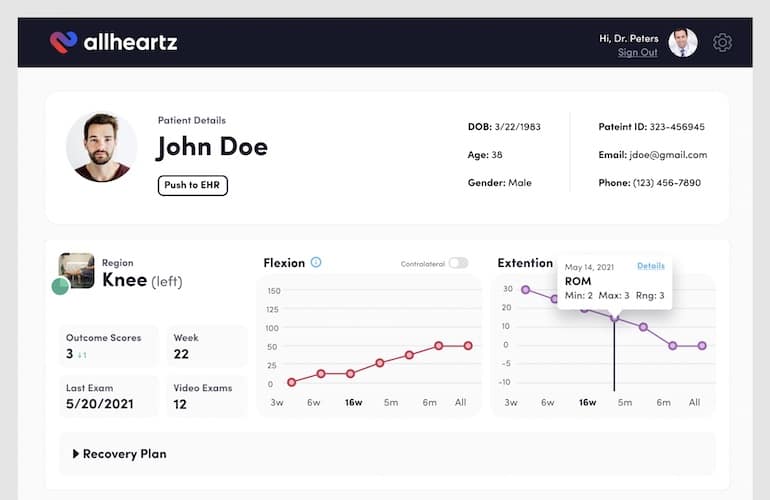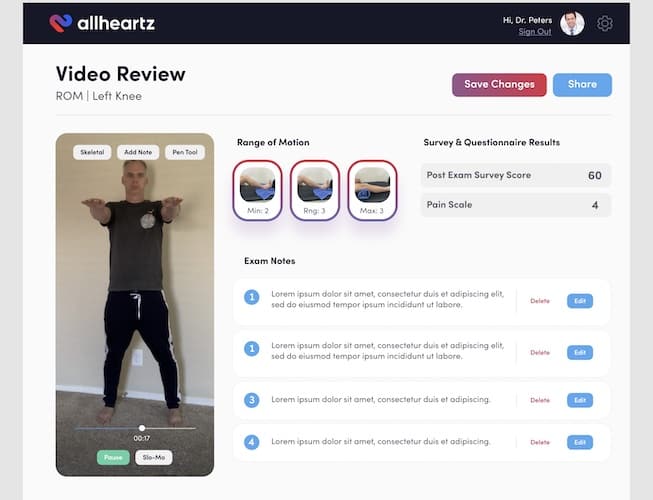Since the Covid-19 havoc, telemedicine and remote patient monitoring have turned healthcare software into an indispensable tool. And physiotherapy is not an exception. Keep reading if you want to develop a physiotherapy app and want to learn the specifics of the process.
We’ll help you cover all the bases and share our experience in the field.
Top Takeaways:
- On-demand physiotherapist app development involves the creation of patient apps, provider software, and a CMS for providers to manage exercises and other in-app content.
- The most promising technologies worth exploring when making a physio app are machine learning, augmented reality, and IoT.
- Think through the platforms you want to target from the start. Because if halfway through development you’ll decide to include TVs or smartwatches, extra effort will be required.
Table of Contents:
1. Why Develop a Physical Therapy App
3. Key Features of a Physiotherapy App for Patients
4. Key Features of a Physio App for Physiotherapists
5. 6 Steps of a Physical Therapy App Development
- Step 1: Discovery
- Step 2: Proof of concept (optional)
- Step 3: Design and prototyping
- Step 4: Development/QA sprints
- Step 5: Deployment
- Step #6: Maintenance
6. Cost of a Physio App Development
7. Topflight Experience in Physiotherapy App Development
Why Develop a Physical Therapy App
Physio therapy applications fall into steps of remote patient monitoring software, offering the same benefits:
- Improved patient outcomes
- Considerable economy of cost and time for everyone involved
So, essentially, you develop a physiotherapy app to make the care more affordable and effective. How is that possible? I bet you know the answer better than me. Nevertheless, let’s point out the reasons:
- No need to travel to a hospital or rehab facility and wait in line.
- Most times, patients can self-manage their rehabilitation with minor oversight from a PT.
- Doctors and patients can communicate regardless of their location.
- A physio app, strange as it may sound, has a better chance to educate, motivate, and help patients otherwise — because it’s always around.
- PTs and patients have unlimited access to patient data and so can review and improve the treatment program.
You may wonder, “Well, why should I build my stuff? Isn’t it easier to subscribe to some physio SaaS?” Consider this:
- You’ll need to research at least a handful of applications and try them out in your clinic to find a fitting one.
- You won’t be able to tailor the user experience to your patients’ needs.
- The same goes for PTs’ user experience.
- New features appear at a vendor’s discretion.
- Competition is using the same tools, so no chance to stand out.
Of course, you won’t have to wait till the physio app gets built out and it may seem to cost less when you first sub to a service.
However, monthly contributions will eventually add up, and you’ll discover there’s a bunch you need to pay for separately. If you really know your business, it’s better to become a vendor yourself.
Top 3 Physio Apps
Let’s quickly review the most popular physiotherapy applications. Maybe there’s something worth borrowing for our own physio app.
Rehab Guru
Rehab Guru is a powerful exercise prescription software for medical professionals, coaches, therapists, and athletes. They have dedicated mobile software for patients and providers that includes over 5000 exercises.
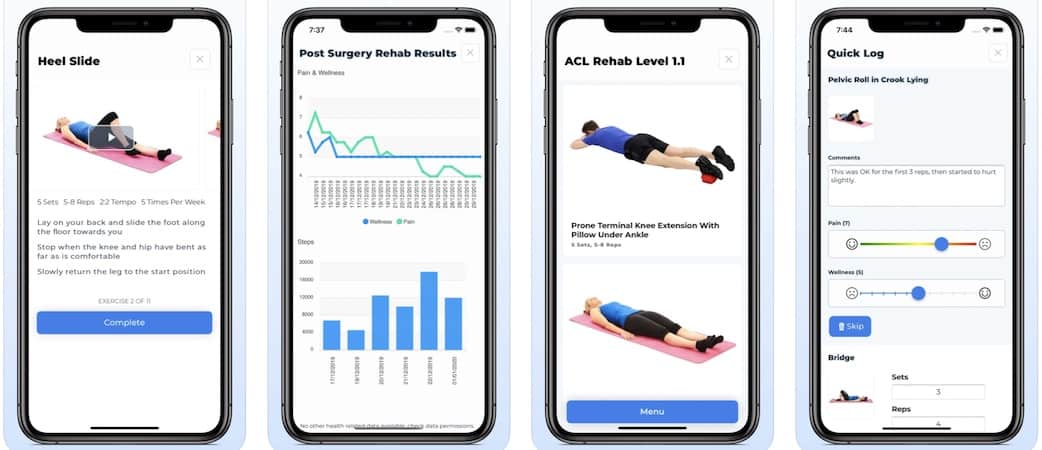
Notable features:
- Treatment notes and patient forms
- Video calls
- Booking and payments
Physitrack
Over 100,000 healthcare professionals use Physitrack all over the world. This platform seems to have one of the most robust feature sets out there: from telemedicine to EHR integrations.
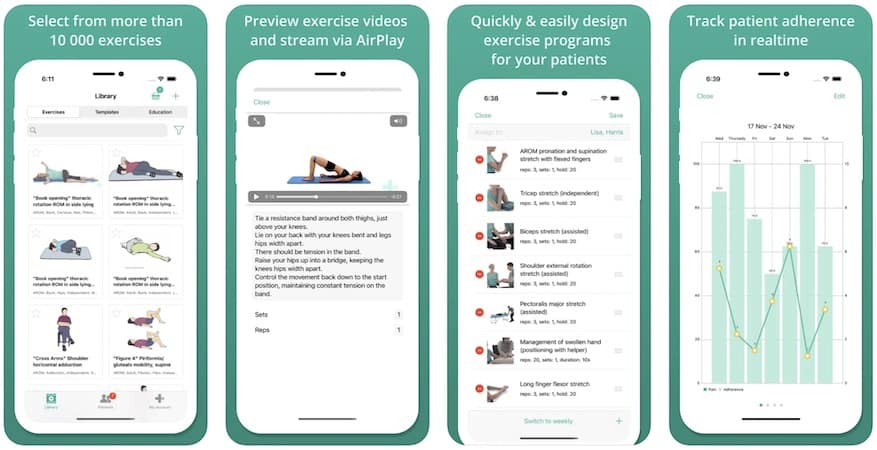
Notable features:
- EHR integrations
- Customizable patient onboarding & triage
- Outcomes analysis
PT Pal
This app reminds MyFitnessPal in its early days. The software works as a quick replacement for paper instructions and surveys so that medical professionals can send exercises, etc. directly to the patient’s phone.
Platforms supported: iOS and Android (patients only), a web application for PTs.
Notable features:
- Integration with CareKit, ResearchKit, and HealthKit
- Dashboard for tracking progress
- Multimedia interface and reminders
Key Features of a Physiotherapy App for Patients
What features besides the user profile and settings should we add into a physio add? Here are a few options I spotted in popular physiotherapy apps and up-and-coming physio startups:
Triage/intake
Think chatbots or surveys. Might want to add an anatomy body chart here.
Exercises
The meat of the software; the reason patients will use it at all.
Outcome analytics
Patients should be able to track their progress and keep their exercise diary.
Reminders
Will be key for increasing home exercise adherence.
Telemedicine
Video calling or messaging and everything that comes with that, including scheduling, etc.
Payments
Ideally, a couple of subscription tiers.
Educational content
Patient education definitely plays a critical role in faster recovery from back pain and other conditions.
Advanced features
Make use of machine learning, augmented reality, IoT, and other modern smartphone capabilities to offer killer features like:
- voice control / intelligent chatbots
- gamification scenarios
- using additional equipment to collect more health data
- recognize and collect data from images/videos
Remember that you only need 2-3 key features in your first public version of the product to gauge the traction. So pick them carefully. Here’s an example:
How about a demo consultation for the patient? A video call is led by a virtual assistant who shows the patient around the app. Thanks to this feature, patients will feel more comfortable and won’t waste time during an actual consultation. Is this feature critical or nice-to-have?
Key Features of a Physio App for Physiotherapists
How about the options in the provider’s app? What should we include there? I’m sure that if you run or work at a physiotherapy practice, you know better than me what goes there. So let’s just list a few features:
- Dashboard with patient metrics
- Treatment plans (exercises, scheduling)
- Managing exercises (adding new, editing, templates)
- Messaging or other means to provide feedback to patients
- Exercise library
- EHR integrations
That’s the bare minimum. You can come up with more exciting features, like pairing the application with smart medical sensors or special connected equipment (for gathering additional data) or automatic transcribing of video consults.
That’s the bare minimum. You can come up with more exciting features like pairing the application with smart medical sensors or special connected equipment (for gathering additional data) or automatic transcribing of video consults.
6 Steps of a Physical Therapy App Development
Developing physical therapy apps requires going through several steps, including one extra step if you envision AI capabilities.
To successfully create a physical therapy app, a structured and iterative approach is essential. Below are the six steps that will guide you through the process of development, ensuring your app is both innovative and user-friendly.
| Step | Description |
|---|---|
| 1. Discovery | Define your app’s features and boundaries, aligned with ROI goals. Collaborate with a development team to draft a roadmap, prioritize features, and explore technical requirements. |
| 2. Proof of Concept (Optional) | For AI-powered apps, validate machine learning models with a functional prototype to ensure they deliver the desired output before UI/UX design begins. |
| 3. Design and Prototyping | Create a clickable prototype from high-fidelity screens. Test it with real users to refine the UI/UX, ensuring the app meets user needs without committing to expensive coding. |
| 4. Development and QA Sprints | Begin coding the app while adhering to agile principles. Incorporate features like gamification, wearable integrations, and large-screen compatibility. Ensure HIPAA compliance throughout. |
| 5. Deployment | Automate app deployment with a robust DevOps strategy, ensuring seamless updates for testing and production environments with minimal manual effort. |
| 6. Maintenance | Monitor app performance and user feedback using analytics tools. Update technical components to ensure compatibility with the latest OS updates and address user needs. |
For run-of-the-mill physiotherapy app development, the procedure wouldn’t differ much from the one you follow to create a medication tracker & pill reminder app or other typical medical software:
- Discovery
- Design and prototyping
- Development/QA sprints
- Deployment
- Maintenance
As for the extra step required for an AI/ML-equipped physio app, we’ll need to include a proof-of-concept phase somewhere between discovery and design. This PoC step helps verify initial machine learning models in that we get the expected output.
For example, when we worked on a physiotherapy application with computer vision, before designing the UI/UX, we had to check a few machine learning models.
Tracking patients’ body movements and dissecting their goniometric data were crucial. Therefore, we cobbled together a proof of concept before proceeding with full-fledged physio app development.
Anyway, let’s take one step at a time to understand how this all works together.
Related: Healthcare App Development
Step #1: Discovery
To build a physical therapy app that anyone will want to use, we need to define its boundaries and decide on a feature set tied to our ROI goals. How do we do that?
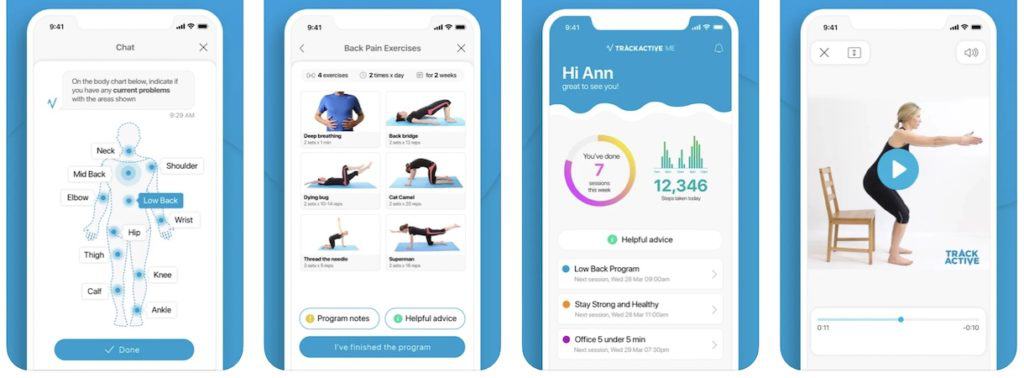
With this encapsulated product vision, we can proceed to the next step.
Step #2: Proof of concept (optional)
NB: This step only comes into play if we make a physio app with AI features. Its sole purpose is to slap together a functional prototype, which doesn’t require any design, to see how well machine learning algorithms perform.
Look, the ML part can have different implementations, e.g., computer vision, OCR, or NLP, depending on the software goals. In a nutshell, we scrap together a little something with minimal to no interface, but charged with an ML model underneath. We then feed some data into the model to see if it returns the desired output.
Check out our blogs about ML app development if you need more details about this step.
Step #3: Design and prototyping
I can’t stress enough how important that step really is. You won’t believe how many lackluster apps I have seen that could have generated decent traction if their founders had started with prototyping.
Ultimately, no provider- or patient-centric application can live without a UI, right? However, designing a physical therapy app is only the half of it because the UI/UX need to be tested with real users.
Therefore, using the designed screens, we put together a dynamic click-through prototype and have test users run through it. Their feedback is then incorporated into the next iteration until we have a sense of building an intuitive, powerful solution.
Best of all, we haven’t yet started coding at this point, which means the development budget stays practically intact. Were we to experiment this way with code instead of prototyping, we’d be out of money by now.
Step #4: Development/QA sprints
Development and design of a physical therapy app make for the most exciting projects. Application developers definitely love them because they get to work with innovative technologies. More importantly, a genuinely engaging user experience is practically guaranteed. Just think of all the possibilities with AI, AR/VR, IoT, and big screens.
Big screens?
Yes. I’d argue that physio apps are ideal for TV screens, not just iPhone and iPad. For example, the physio software we built for Allheartz allows patients to cast the screen to a TV. That means as they record themselves doing exercises, they can see prompts on a big screen and correct the posture accordingly.
Hell, you can even consider building a standalone TV app optimized for large screens. Based on your audience, this may be the clincher, setting you apart from the competition.
Gamification
The augmented reality tech can help us create more engaging experiences. Adding virtual objects on the screen while also tracking patients’ movements unlocks limitless gamification mechanics.
Wearables
Being able to read and consequently analyze more health data has always been a killer feature for many healthcare apps. Imagine what you can do if you create a physical therapy app that connects to a space-aware sensor, which not only guides patients through exercises but also gathers critical health and wellness data.
PT-focused app or portal
Of course, we need to program a web interface for PTs to manage exercise and do the rest of the stuff. This web application will connect with the patient’s app and an EHR via APIs.
HIPAA compliance
Since our software will accumulate patient data, we’ll need to implement strong security mechanisms throughout the development and deployment cycles.
At the bare minimum, we cover:
- Identity access management
- Mature incident management
- Disaster recovery planning
- Access, audit, and integrity controls
Related: HIPAA compliant application development
Virtuous agile cycle
Whatever technologies you choose to apply in your therapy app, keep in mind that the development partner should follow the agile principles.
That involves releasing testable versions of the software every two weeks and quickly adjusting to the customer feedback. You probably won’t realize it till the official public release, but the agile development process will absolutely define the success of your product.
Step #5: Deployment
Deployment is very important and goes hand in hand with development. Ideally, we set up a DevOps strategy so that developers literally press one button to make the app available for testers and later for the public.
The goal is to automate deployment to testing and production environments and stop wasting time on manual tiresome tasks. Developers should spend their time on adding features and ironing out bugs; not on continuously making the app available to end users.
Step #6: Maintenance
Maintenance is the last step in mobile physical therapy app development. Once the app is out, it will start generating a lot of positive and probably some negative feedback. To make sense of all the suggestions and complaints, we’ll need to bake performance tracking utilities into the app.
For example, platforms like Sentry and Flurry help us analyze how customers are using the app and pinpoint all issues on different devices.
Another part of maintenance is updating technical components of the app to keep it secure and prone to new OS updates.
Related: Build a Cannabis/Marijuana Delivery App
Cost of a Physio App Development
The cost to develop an on-demand physiotherapists app starts at around $120,000. The total, of course, will depend on how many features it takes to generate the required effect with the solution. Plus, you should take into consideration the platforms you’d want covered and the use of advanced technologies like machine learning and augmented reality.
Topflight Experience in Physiotherapy App Development
The Allheartz app is a perfect example of how you start a physio app. In fact, the software is a little more than an AI-powered mobile app for patients to follow their rehab routine.
As mentioned, the software tracks, measures, and analyzes such data as flexion, extension, and other goniometric data.
In addition, the app sends this metrics to physios, who can provide feedback right in the video or via comments. Doctors naturally can customize the treatment plan and review patient stats. And, of course, all health data syncs with an EHR platform.
Related Articles:
- Healthcare Mobile App Design Guide
- How to Build a Doctor’s Appointment Application
- Computer Vision in Medicine
- How to Create a Telehealth Application
- A Guide to Healthcare App Development
- Remote Patient Monitoring App Development
Yes. Yes, most of the time, yes. At least partially. Absolutely, if you already have some EHR at your practice, the app should integrate with it. You can also get the app ready to connect with other EHR systems. Not really. It’s one thing if you want to build an app with video calls or RPM features, and it’s quite another if you need AI/ML or other capabilities. Get in touch to get advice specific to your app idea. An MVP (minimal viable product) should be doable within four months.
Frequently Asked Questions
Can you manage the real time video AI analysis with telemedicine so that the software can assist physios with diagnosing right during a consultation?
Can I reuse some code from the patient app in the dedicated app for physical therapists?
Can I integrate my physio app with an EHR?
Would you recommend any particular tech stack for a physio app?
How long does it take to build a physio app from scratch?
